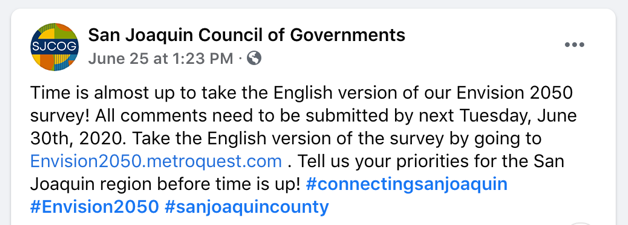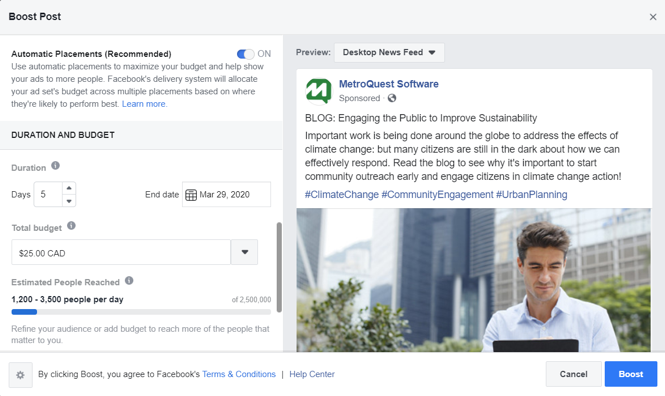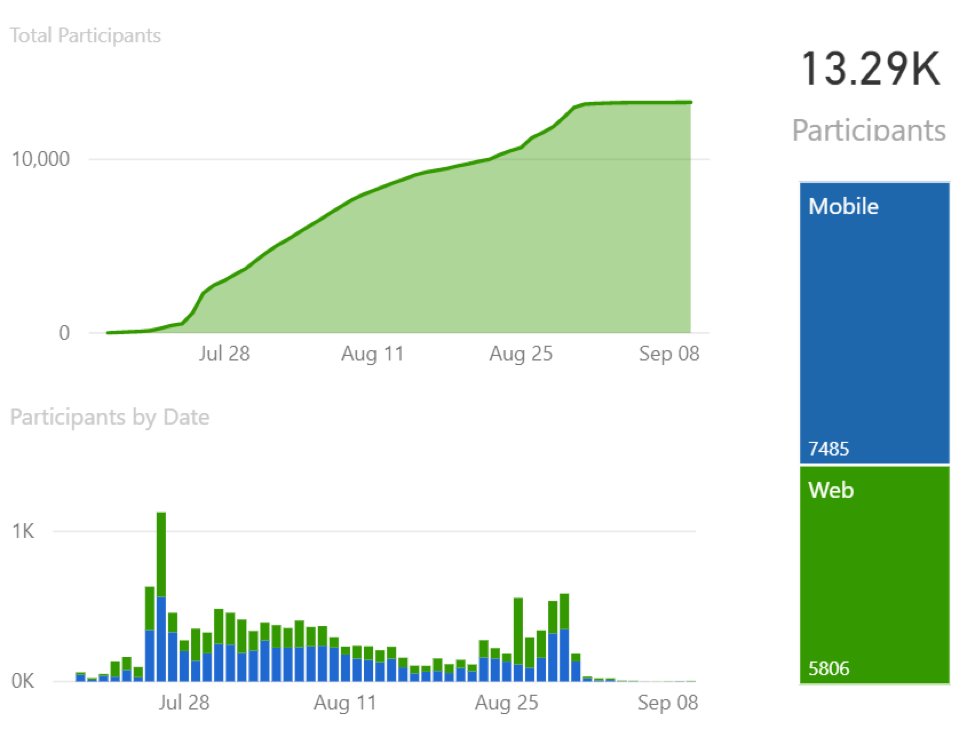5 Tips for Using Facebook to Effectively Promote Your Public Engagement Survey

Prior to the COVID-19 pandemic, the most common challenge reported by planning agencies was “low participation.” This was particularly evident during public meetings, where the average attendance was just 9 people!
Today, as agencies nationwide are required to comply with mandates and consequently forced to postpone, cancel, or suspend previously scheduled public meetings, many have shifted their outreach efforts exclusively to online platforms. Despite the adjustment, this transition has enabled thousands of planners to reach a larger and broader audience for only a fraction of the cost of the traditional town hall methods.
With this change and increasing considerations around online engagement, diversity, and equity, we want to share a successful strategy that we’ve seen repeatedly utilized by our MetroQuest clients. If you want to grow those 9 public meeting attendees into thousands of online public input participants, read on for a how to guide! We’re here to share some of the latest tips on how to maximize the impact of your Facebook presence in order to improve the results of your community engagement campaigns.
Effectively Advertise Community Engagement with Social Media
There are many online advertising tools that are inexpensive and compliment modern survey tools like MetroQuest perfectly. By pairing smart public input software with cost-effective online advertising, agencies have successfully engaged thousands of participants online at a significantly lower price than the conventional advertising methods. The tool Nextdoor is a great example; agencies such as the City of Austin have successfully used it to engage over 5000 residents. Another great tool is Facebook, particularly its paid advertising option called “boosted” posts.
The benefit of using online advertising over traditional methods are wide-ranging, but most importantly it is more cost-effective and allows for a much broader reach. Rather than spending thousands of dollars on print material, digital advertising for community engagement means that you can commission a poster or digital ‘flyer’ and pay the service provider to distribute it. The costs vary by provider, but currently Facebook has some of the lowest “cost per interaction” than any other social media platform.
With solutions like Facebook boosted posts in your toolbox, you can also target your promotions to ensure that you’re reaching your public participation goals. Plus, given that many of your residents are already spending time on Facebook, your reach and impact is improved just by moving onto platforms where your audience already spends their time.
5 Tips for Using Facebook for Excellent Community Engagement
Most likely, social media is already a part of your engagement strategy—great! The first step to online promotions is using your ‘organic’ reach, meaning posting regular updates on your project or agency’s Facebook page so that people who already like or follow your page get updates consistently and instantly!
Here are some tips and reminders for effective posting on Facebook, but they can also be applied to other social media platforms like Nextdoor or Twitter:
- Create hashtags specific to the project and include them in each post. Encourage people to use them when they’re talking about the project on their own accounts! Hashtags help residents find, follow, and contribute to the conversation. It also allows you to keep an eye on what is being said about the project.

- Review the reactions you receive to your posts and respond to comments where appropriate. Interacting with engaged users goes a long way in helping them stay engaged and feel heard!
- The posts’ tone should be relevant, simple, and avoid jargon or acronyms. Be sure that you’re matching the tone of the survey itself! A simple worded survey will help keep participants engaged throughout. If posting more than once, ensure your posts are complimentary to each other and consistent in tone and message.
- Create a follow up post that includes a final call to action shortly before the survey closes. Include some initial results or successes to encourage people to share their opinion and have their voice heard as well!
- Use images – pictures of people are especially attention-grabbing! You can also use digital flyers that have more information about the project and survey.
How to Create a Facebook Boosted Post to Promote Your Project
First, in order to create a boosted post, your agency needs to have a Facebook page (or at least a page for the project that you’re promoting a survey for), and you have to have permission to post and advertise on the page. For the post itself, you have two options: boost an existing post, or create a new post to boost.
To create a post and then boost it, follow these steps. If you already have an existing post to boost, start from Step 3!
- Go to your Facebook Page. You do not need to have a dedicated page for the project.
- To create a post, click into the “Create Post” text field and start typing. You may add images, links, hashtags, etc. Click “Post” once you’re done. You can also select “Publishing Tools” for additional options, such as scheduling the post to publish at a later time.
- If you already have an existing post to boost, start here. To boost a post, locate the post and then select “Boost Post” at the bottom-right corner.

- Follow the instructions to fill in the details of your advertisement, which include:
- Audience: Choose a recommended audience or create a new audience based on specific characteristics. For example, you can select people who already like your page, extend it to their network of friends, or select a new audience based on age, location, interest, and so on.
- Total Budget: Select a recommended budget or provide a custom budget. Don’t use all your allotted budget at once; you can always boost a second post to capture more input from certain demographics as needed.
- Duration: Select one of the suggested time frames or provide a specific end date. The post’s daily budget is created based on total budget and duration that you set here.
- Payment Method: Review your payment method. If you need to, you can change or update it.
- When you’re finished, select “Boost”.
Once your campaign is running, check in periodically to monitor the results! To view the results for a boosted post:
- Go to your Facebook Page
- Select the Ad Center tab and then select “All Ads”
- Find the ad and select “View Results”

Monitor results in the Ad Center to see how many clicks you’re getting. Survey software like MetroQuest can provide more accurate info on how many people who visit the webpage also complete the survey. If you included it in your survey, MetroQuest’s data center will provide demographic information on people who filled out the survey. By using the two tools together, you can work to improve the performance of your online community engagement and ensure that you’re receiving input from a broad and representative demographic and adjust your outreach efforts as appropriate.
For example, check your MetroQuest Data Center a few weeks into the survey going up, and review the demographic information of respondents. If you see that the majority of the respondents are from the same demographic, you can promote the survey to the underrepresented communities through an additional Facebook boost.
If there are certain communities that your agency wants to hear from for a particular project, identify whether they were a significant part of your MetroQuest survey results and target them in subsequent Facebook boosted posts. Use zip codes and geographic location to make sure that your survey results come from the most representative and diverse range of respondents possible. Get creative! Social media platforms like Facebook, and software for public engagement like MetroQuest, are elements in your toolbox that you can use to achieve the best possible results for your community engagement campaigns!
More on Boosted Facebook Posts for Successful Online Engagement
To learn more about creating posts on Facebook, please click here.
For more information on boosting posts on Facebook, please review the help content on the topic here.
The cost for advertising with Facebook is minimal. It’s also simple and fast, and it allows agencies to reach a broad audience, beyond its current followers on Facebook.
Not convinced? I’ll be sharing a post shortly on how the South Carolina Department of Transportation engaged 13,000 people with Facebook boosted posts!
SCDOT Engaged 13,000+ Residents on a Tiny Budget
Can’t wait? Hear Nicole Riddle, Public Involvement Coordinator (& Biologist) at the SCDOT, discuss their strategy and success with paid Facebook posts in our on-demand webinar. Join me in congratulating Nicole on her outstanding public engagement success!

Norma, you have shared the best & effective tips for using Facebook to effectively promote public engagement survey.
Thanks, for updating us with such kinds of information.
Hello, Norma Hogan.
Your article is really beneficial for me in which you have listed the 5 tips for using Facebook for promoting public engagement survey effectively.
Thanks, for sharing with us. Keep Updating Us.